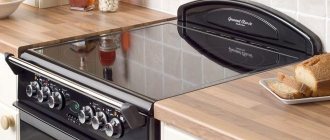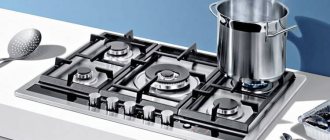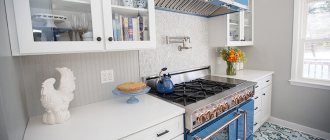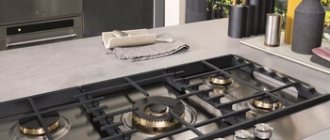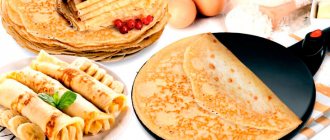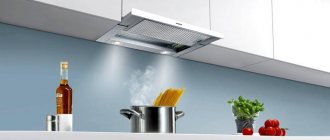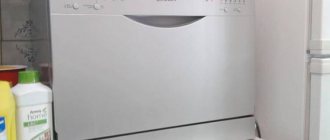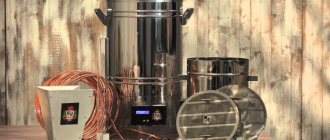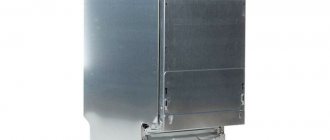When purchasing a new home or carrying out major renovations to an existing one, everyone wants to do everything in a design that is original and at the same time practical. It is impossible to achieve both one and the other without the use of nanotechnology. After all, only fashionable new equipment has both a magnificent appearance and extensive functionality. One of these modern attributes in kitchen furniture is the glass-ceramic stove. Let's try to determine the pros and cons and find out: is this a really stylish, practical thing or just a whim of the rich? Or maybe the costs of modernity? Or is it still a necessity that alleviates a woman’s lot?
Advantages
Among the advantages are noted:
- Supports instant heating function.
- Resistance to high temperatures.
- A high-quality stove with a glass-ceramic surface is characterized by low horizontal thermal conductivity and relatively high vertical thermal conductivity.
- High strength.
- Low power consumption compared to stoves that run on gas. Experienced users consider a glass-ceramic stove as a saving tool. Today, gas tariffs are rising every day, so electricity consumption will be cheaper.
- The glass ceramic coating cools quickly. This allows for a dynamic response to changes in switch position. Until recently, this was characteristic only of gas surfaces.
- Selecting a heating zone. You can regulate the heated area yourself. This allows you to use dishes with different diameters.
- Possibility of using dishes of specific shapes. Depending on the model of the glass-ceramic stove, the shape of the burners can be not only round, designed for dishes with a round bottom, but also other shapes that make it possible to use a caterpillar, as well as vessels of various configurations.
- Advanced functionality. If previously the main purpose of the stove was cooking, now there is a timer function, automatic shutdown when boiling, auto-cooking mode and others. All this makes the housewife’s work easier and does not require her full participation.
- Child protection. Another feature of modern models of glass-ceramic stoves that allows you to prevent children from accessing the unit’s navigation and avoid various kinds of troubles.
Types of burners
A modern electric stove is easily recognized by its flat, smooth surface, on which the burners are almost invisible. Usually they are only slightly marked by contours of different shapes and sizes. Not only the cost of the furnace, but also the efficiency of its operation depends on what element is inside.
Glass ceramics usually have one of the following types of burners:
- Halogen burners heat up instantly (up to 3 seconds) due to a special lamp connected to a high-temperature spiral. During operation they glow with a soft red light. Their high power allows you to quickly heat water or fry meat well. The only drawback is the relatively short service life of halogen lamps and high energy consumption.
- Rapid burners heat up a little slower (up to 12 seconds), but they are more reliable and economical. Inside them there is a spiral made of a high-resistance alloy, capable of releasing a large amount of heat when heated. A more modern version of these burners is “Hi-Light”. In them, the spiral is laid much more tightly, due to which the burners heat up and cool down a little faster (up to 7 seconds).
- Induction burners are capable of heating the bottom of special cookware. They are considered the most effective and economical. However, glass ceramics with induction burners are not cheap. And if you take into account that you will have to buy special dishes for it, it actually comes out to a decent amount.
Most often, the manufacturer supplies the stove with burners of different power. This is much more convenient, as it allows you to use electricity more economically. It is best to choose an electric stove, each burner of which has a different diameter. This way you can spend exactly as much electricity as you need at the moment.
Flaws
The glass-ceramic stove has pros and cons. The latter, according to owner reviews, include:
- The need to purchase dishes from certain materials. Depending on the type of burners (standard, induction, Hi-light, halogen) you can use one or another cookware on the stove.
- Specifics of care. A glass ceramic hob requires special care. Cleaning the surface must be done with a special tool using appropriate household chemicals, which usually cost a lot.
- Strong static loads are contraindicated.
- Precision strikes are contraindicated.
- Low sides. This means that if, for example, soup or milk escaped during the cooking process, then you will have to catch it on the floor. Consequently, not only the working hob, but also the floor will be contaminated.
- "Diabetes". The glass-ceramic stove is very afraid of sugar, both in its pure form and in liquids (jam, jam, syrup, etc.). It is almost impossible to clean burnt residue.
- Sudden temperature changes are contraindicated. When the stove is in operating mode, that is, turned on, you should avoid getting cold liquid on it. If this happens once, there is no need to worry, but if this happens systematically, it will soon cause the slab to fail.
Analyzing the above, we can conclude that the disadvantages of glass-ceramic stoves are the complexity of operation and the need for maintenance. In this aspect, traditional electric stoves benefit, of course. But such a drawback is nothing compared to the performance characteristics.
Types of cookers
All glass-ceramic hobs have a glass-ceramic work surface in common. However, the types of heating elements under the hob vary. By type of heat source, devices are classified into:
- electrical;
- induction;
- gas.
The operating principle of electric and gas stoves is similar: temperature is transferred from the heat source to the panel, then to the cookware.
The operation of an induction cooker is different: the induction current heats the cookware directly, bypassing the panel. This gives rise to a number of main advantages of induction cookers:
- safety – the surface of the table is heated only by the pan, so the neighboring areas are relatively cool. It is difficult to get burned by a non-hot surface even with a strong desire. In addition, the boiled-off broth will not burn, as on the hot surface of a gas stove;
- energy efficiency. Now there is no need to select the diameter of the dishes: the pan is heated directly, unlike conventional electric stoves, where the entire heating element is heated, despite the smaller diameter of the container. Electricity is used sparingly.
All stoves, the hob of which is made of glass ceramics, compare favorably with their outdated predecessors.
Induction glass-ceramic hobs have more advantages, however, the final decision is up to you.
Which utensils can be used and which cannot?
A glass-ceramic stove requires a special selection of cookware. The pros and cons of this criterion, which must be observed according to the operating rules, converge. So, purchasing new cookware is primarily costly from a financial point of view. But if you buy the right utensils, you will be guaranteed a quick cooking process and a long service life of the stove.
You might be interested in:
3-burner electric hob, built-in - 3-burner electric hob: built-in golden mean
Combination hob - Combination hob: the best choice for a modern kitchen
Gas hob 3 burners 45 cm - Gas hob 3 burners: built-in and wonderful
Glass-ceramic hob - Glass-ceramic hob: new fashion or super technology?
Page tags:
Features of choosing dishes
- Smooth, undeformed bottom.
- The diameter of the bottom of the pot or frying pan must match the diameter of the burner.
- Aluminum and copper utensils cannot be used. Some manufacturers of hob surfaces overlook this issue, but in practice it has already been proven that the use of pots, pans and kettles made of these materials can lead to the appearance of pearlescent stains on glass ceramics, which in most cases cannot be washed off.
- If the hob is equipped with induction-type burners, then the cookware should be steel, enameled or cast iron. The use of utensils made from other materials is strictly prohibited. In addition, the bottom of the cookware for induction cookers must have ferromagnetic properties. Checking their presence is very simple - just place a magnet at the bottom of the container. If it is attracted, it means that a ferromagnetic element is present and such cookware is suitable for use on “smart” hobs. The same cannot be said about containers made of glass, porcelain, copper, brass, and ceramics.
What to consider when choosing a model?
To choose the ideal option for you, you should keep in mind some criteria:
- Connection type. It is difficult to use a gas stove in a house where there is no centralized gas supply.
- Functionality: Having a lock, automatic shut-off, electric grill and other useful extras makes life easier, but also increases the cost.
- Equipment - with or without oven? Free-standing or built-in? Answer these questions, keeping in mind that the built-in kit will cost more.
- Hob type – classic burner or glass ceramic. If you've used hotplates before, maybe you should try something new? Of course, modern coatings impose certain maintenance requirements, but this is just a matter of habit.
- Dimensions. An appliance that is too large for your kitchen will become annoying over time.
- Easy to care for. Modern ovens are equipped with a cleaning system using the pyrolysis method: contaminants burn out under high temperature. What more could you ask for? Touch control of the table, as opposed to buttons and knobs, will facilitate manual cleaning.
- It's a question of price. Think about whether in everyday life you need all the additional functions of an expensive stove or can you get by with a budget option with a simple set of options?
- Appearance. The device should be pleasing to the eye and harmonize with the kitchen furniture, because housewives spend so much time in the kitchen.
By taking the above nuances into account, you reduce the risk of a useless purchase. All you need to do is choose a model!
How to care: features of maintenance of ceramic slabs. Basic Rules
- Use scrapers to clean glass ceramic hobs. Yes, only scrapers. It is strictly forbidden to clean the surface with a knife, a brush, a sponge with a metal surface, or abrasives. The scraper effectively combats various types of contaminants using removable blades. In most cases, such a device comes complete with a hob. But if you don’t find a scraper, don’t worry, purchasing it separately won’t be difficult.
- Use creamy substances to clean glass-ceramic kitchen hobs. Cream or paste eliminates the possibility of scratching glass ceramics. In addition, when such a substance is applied, a so-called protective layer is formed, which prevents scratches to some extent.
What can ruin glass ceramics?
- Glass-ceramic coatings are characterized by high mechanical strength and are able to withstand very significant loads during kitchen operation. But they are afraid of targeted strikes. For example, falling a knife with its tip down can lead to the formation of a web of cracks. In practice, such a nuisance is rare, but in theory anything is possible.
- You should not place wet and cold dishes on a hot burner; it is recommended to avoid cold splashes of water on the hot surface. Perhaps nothing terrible will happen the first time, but if this prohibition is systematically violated, glass ceramics may not withstand it.
- The glass-ceramic panel of a tidy housewife will last much longer than that of a forgetful lady whose liquids constantly “run away”, ending up on neighboring burners that have not yet cooled down. The destruction of the coating structure occurs gradually and is not immediately noticeable. But, sooner or later, cracks will become visible and the panel will become unusable.
- Dishwashing sponges with detergent or grease residue are completely unsuitable for cleaning glass ceramics. They can do more harm than good due to contaminants transferring to the hob.
Is it worth choosing glass ceramics if there are so many difficulties in its operation? Of course it's worth it. After all, it is not only beautiful, but also very convenient and profitable.
Take my word for it that a description of the operating features of conventional enameled electric stoves with pancake heating elements would take up no less space. In addition, all possible problems are described here, some of which will never happen with one single slab. In fact, a hob or stove with a glass-ceramic panel can last a long time and be trouble-free.
Such attention is paid to glass ceramics precisely because it has recently appeared on the market, and for many housewives it seems to be an unexplored novelty. However, every woman is able to appreciate the unique thermal conductivity of glass ceramics, which allows cooking dishes much faster than using a standard enameled electric stove.
Glass ceramics are changing the idea of kitchen aesthetics. Even gas stoves are now being equipped with glass-ceramic surfaces. That is why the issues of technology for caring for glass ceramics will not soon lose their relevance.
What is possible and what is not? Other nuances when caring for glass-ceramic surfaces
It is extremely undesirable to subject a glass-ceramic stove to strong statistical loads. In addition, you should avoid pinpoint impacts in every possible and impossible way, and also avoid scratching the surface. And remember, the hob must always be clean, since permanent contamination is contraindicated for these stoves.
As already noted, the glass-ceramic stove has its pros and cons, but despite this, it is a priority among modern consumers. The positive characteristics are defined more from a technical point of view, while the disadvantages are due to operational features and require the investment of certain funds.
Useful little things
Modern stoves can provide you with the following features:
- Touch control. It is best to choose a stove with touch controls: such models are more expensive, but they allow you to smoothly regulate the temperature of each burner and look more aesthetically pleasing. In addition, smooth surfaces without unnecessary protruding handles are much easier to maintain.
- Residual heat indicators are a very useful feature of modern ovens. With their help, you can use energy more efficiently: you always see which burners are still hot and how much heat is left in them.
- Booster is a temporary increase in the power of one of the burners at the expense of all the others. This function is convenient to use for quickly heating water.
- Programming – you can program the stove to cook your favorite dishes.
- The timer is useful not only for the oven, but also for the hob.
- Automatic boiling control - the oven itself will detect when the water has boiled and reduce power.
The more possibilities glass ceramics has, the more expensive it will cost. Some of the functions will seem superfluous to you, while others you will consider indispensable. Buy a stove that best meets your expectations.
Advantages of glass-ceramic stoves
- A distinctive feature of glass ceramics is thermal conductivity. It heats the hob only vertically. Therefore, the thermal energy is distributed only to the bottom of the cookware and not to the hob.
- The glass-ceramic panel cools down instantly, so by reducing the heating power, the temperature decreases at the same rate.
- The burners operate at different temperatures. For example, automatic heating reduction - the power is automatically reduced during the cooking process.
- The size and diameter of the heating elements can be changed, as a result of which the heating zone changes. Cookware with different bottom diameters is placed on the same burner. This leads to careful consumption of electricity.
- The shape of the schematic pancakes also changes, so food is cooked in oval-shaped pans made of heat-resistant glass, a duck pot or a goose pan.
- Burners with boil control function significantly reduce the time spent near the stove. To do this, the burners are initially turned on at low power and in the tracking mode. Having heated to the boiling temperature, it automatically decreases to the programmed temperature.
- Ovens of such models are manufactured with lighting, a temperature sensor, ventilation, an electric grill and a catalytic cleaning system.
- The smooth and matte surface transforms the interior of the kitchen, giving it a neat appearance and ennobling it.
Choosing cookware for a glass-ceramic hob
Glass-ceramic cooktops require certain metal utensils made of stainless steel with thick walls and bottom.
The main criterion is a smooth and flat bottom, which will ensure minimal heat loss during sudden heating, and the diameter corresponds to the size of the burner.
It is desirable that it have a bottom with a low reflection coefficient, that is, matte or dark in color. Inscriptions and embossed images are not allowed on the outer surface of the bottom of the cookware. There should be a mark on the box that the cookware can be used for glass-ceramic stoves.
Stylish and modern corner small kitchens are what you need when space is limited. Do you want to know how to make the interior of a small kitchen with a gas heater? Come here!
Not recommended for use
- Old dishes. Even if it seems smooth, it is not recommended to use it. If you zoom in too much on the surface, you can see irregularities.
- Copper and aluminum cookware are not suitable for use on this stove. Heating these metals can leave marks on expensive surfaces. Using heat-resistant glassware is not an alternative solution. It takes a long time to warm up, so cooking time increases.
Brands and manufacturers
CorningWare Pot and Other Kitchenware in Cornflower Pattern
Some famous brand of glass ceramics are glass ceramics, Ceran (cooking), Eurokera (for cooking, stoves and fireplaces), Cerodur (telescope mirrors) and Macor, Kanger (glass ceramics for cooking, stoves, microwaves and fireplaces doors). German manufacturer Schott introduced Zerodur in 1968, and Ceran followed in 1971. Nippon Electric Glass is another global glass-ceramic manufacturer whose related products in this area include Firelite and Neoceram fire-resistant glass. Keralite, produced by Vetrotech Saint-Gobain, is a specialized glass-ceramic fire-resistant and impact-resistant material for use in fire-resistant environments. Glass-ceramics produced in the Soviet Union/Russia are known as Sitall. This same class of material was used until the late 1990s in CorningWare cookware, which could be taken from the freezer directly to the oven without the risk of thermal shock. Sources:
- eurokera
- robax schott
- Schott Ceran
- wikipedia
Review of interesting porcelain glassware
Placing a glass-ceramic pan in the oven or placing a pan on gas is only permissible if the manufacturer has permitted it. Each manufacturer has its own recipes and production technologies, this should be kept in mind when choosing. Carefully study the characteristics of the product.
Glass ceramic tableware set, decorated with flowers, includes 19 pieces. In addition to dinner and dessert plates, the set includes six small and one large salad bowls. The plates can withstand freezing, heating in the microwave, and washing in the dishwasher.
A glass porcelain tea set of 15 pieces is suitable for both a festive feast and every day. Durable cups are scratch-resistant, resistant to temperature changes, and easy to clean. In addition to cups, the service includes a teapot and a sugar bowl.
Snow-white glass-ceramic ramekins are suitable not only for baking soufflés. You can use them to freeze desserts, serve salads, or prepare portioned hot dishes in the oven or microwave.
MAXWELL&WILLIAMS glass ceramic pan with a capacity of 3 liters is designed for cooking on the stove and baking in the oven. The glass lid helps you monitor the process and control the boiling level.

